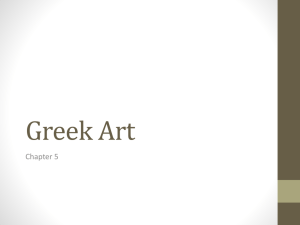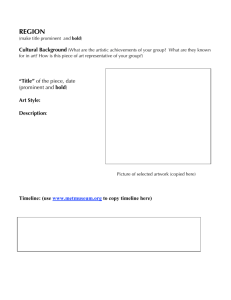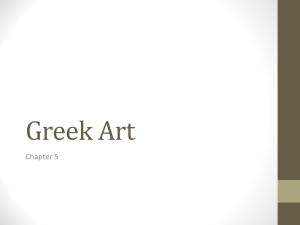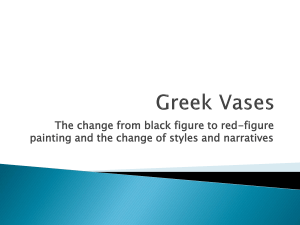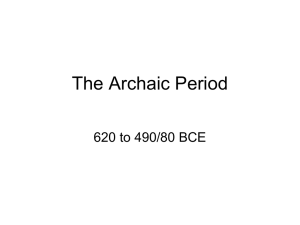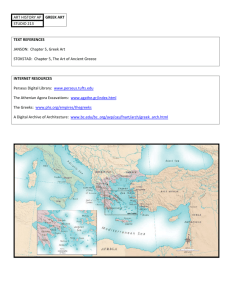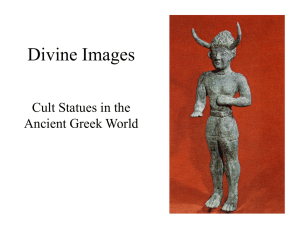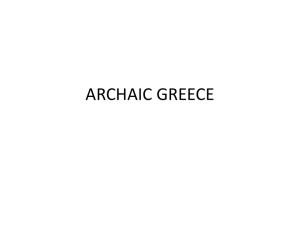APAH - CHAPTER 5-3 - Point Loma High School
advertisement
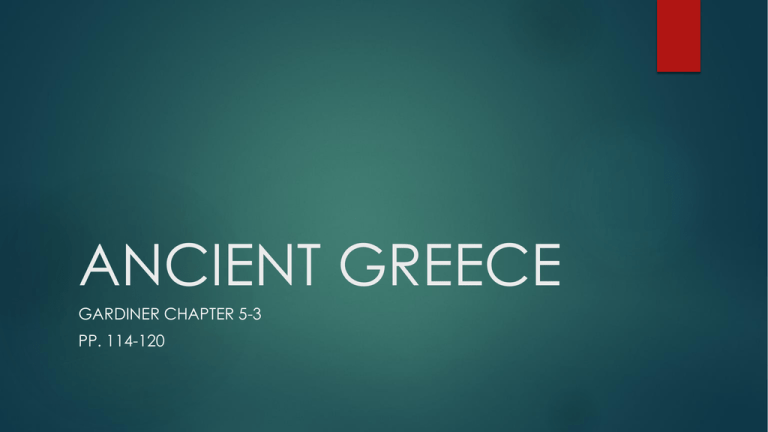
ANCIENT GREECE GARDINER CHAPTER 5-3 PP. 114-120 FRANCOIS VASE Archaic painted vases -> artist signatures -> mid 6th century Athenians learn the black-figure technique from the Corinthians The masterpiece of Athenian blackfigure painting Krater, 570 BCE 200 figures, 6 registers, lablelled figures 1 band Orientalizing animals and beasts, other 5 an encyclopedia of Greek mythology Focus on Peleus and his son Achilles, and Theseus -> composite type figures EXEKIAS Achilles and Ajax playing a dice game Detail from black-figure amphora, 540-530 BCE, 2’ high Exekias = Athenian master of black-figure technique Didn’t use a series of bands -> instead, a single large framed panel Gravity and tension -> “the calm before the storm” Dark silhouettes and incised details BILINGUAL PAINTING Andokides Painter Achilles and Ajax playing dice Athenian bilingual amphora Same composition on both sides -> one side black-figure, other side red-figure Red-figure = outlined the figures, background is black, red clay for figures, interior details drawn w/a soft brush instead of incised EUPHRONIOS Depicts Heracles wrestling with Antaios Athenian red-figure krater 510 BCE, 1’7” high Diluted/thinned glaze to depict hair, musculature Deliberately rejects the conventional composite posture for the human figure -> instead, he reproduces how a particular human body is seen -> protagonists moving in threedimensional space EUTHYMIDES Three revelers Athenian red-figure amphora, 510 BCE Unusual positions of the human form Does not use conventional frontal and composite views Figures are foreshortened -> ¾ view, central figure shown from rear with twisting spinal column and buttocks in ¾ view TEMPLE OF APHAIA, AEGINA Years just before and after 500 BCE a time of dynamic transition in architecture and arch sculpture 500-590 BCE Doric design -> 6 columns on facades and 12 on the flanks -> columns more widely spaced and more slender Capitals create smooth transition from shafts to the architrave Interior -> two colonnades of two stories replace single row of columns -> statue of deity between them on linear axis Pediments featured life-size statuary in place of Archaic high reliefs Theme of statuary is the battle of Greeks and Trojans -> unified theme and consistent scale DYING WARRIOR West pediment of the Temple of Aphaia -> archaic features -> torso rigidly frontal, archaic smile -> mannequin with arms and legs arranged for display 490 BCE East pediment -> radically different -> Classical era -> more natural, self consciousness, shows pain DYING WARRIOR – EAST PEDIMENT OF TEMPLE OF APHAIA EARLY AND HIGH CLASSICAL PERIODS Defeat of the Persian invaders by the allied Hellenic city-states -> Athens is sacked in 480 BCE -> Greeks win epic naval victory over the Persians at Salamis This marks the beginning of the Classical age of Greece Victory nurtured a sense of Hellenic identity strong and distinct from the civilization of Asia TEMPLE OF ZEUS, OLYMPIA The first great monument of Classical art and architecture is the Temple of Zeus at Olympia 470-456 BCE Today the temple is in ruins Even # of 6 columns on ends, two rows of columns in 2 stories inside the cella Lavishly decorated -> statues filled pediments, metopes adorned w/reliefs East pediment of Temple of Zeus, Olympia -> chariot race between Pelops and Oinomaios HERAKLES One of the metopes from the Temple of Zeus -> depict the 12 labors of Herakles Athena, Herakles, and Atlas with the apples of Hesperides Hero holding up the world with Athena’s help Early Classical phase of Greek art is called the SEVERE STYLE
